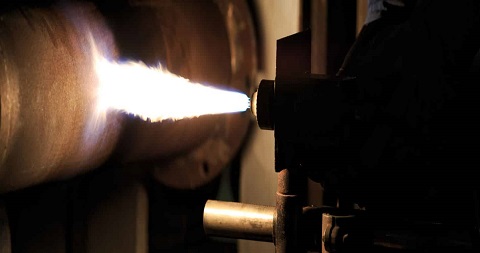Flame spraying is a thermal spray process that creates quality coatings using heat to melt materials that are usually in powder, ceramic rod or wire form. This type of thermal spray method is cost effective and one of the simplest ways to deposit coatings onto a substrate to provide impact resistance and protection from wear and tear.
How does Flame Spraying work?
The flame spraying process is fueled by a heat source that is created by a chemical reaction between a fuel of combustion and oxygen to create a stream of gas. The thermal spray material is then put into the flame in the form of a wire and compressed air is used to atomise the molten particles before propelling them onto the substrate. If you use a powder flame spray, the powder particles are softened by the flame before they are coated by the flame gases and accelerated through the nozzle.
What is Flame Spray used for?
Widely used as a cost effective method of protecting components and structures from damage and corrosion, flame spraying is used on a variety of different substrates. When equipment or a structure is required to have a high resistance, flame spraying is used to apply metallic and ceramic coatings so they are suitable for the environment they are being used in.
What are the Advantages of Flame Spraying?
Cost effective
Flame spraying will is not as costly as many other forms of spraying due to the nature of the process and the finished quality of the coating.
Lower dust and fume levels
With lower dust and fume levels than plasma and HVOF spraying, flame spraying can be used without a spray booth and also has lower noise levels.
Coat complex geometry
Due to the nature of manual flame spraying, it is easier to coat equipment and components with complex geometry.
Portable and easy to use
Compared to other thermal spray processes, flame spraying is made from a more simple design making it easier to use and it is suitable for manual use without the need for mechanised manipulators.
What are the Disadvantages of Flame Spraying?
Lower-quality coatings
The coatings achieved by flame spraying are of a lower quality than those by other thermal spraying processes. The coatings may have higher oxide levels for metal deposits, higher porosity and a lower bond strength.
Difficult to coat restricted surfaces
Like most thermal spraying processes, flame spraying requires line of sight to the surface to coat, look how to do at alliedexperts.com/. This means it is difficult to coat restructured surface areas or inner surfaces with a smaller diameter.
If you would like to find out more about flame spraying or the other quality coatings we provide for you and your business operations, please don’t hesitate to get in touch. Here at IRS, we are fully committed to providing durability and high performance through our range of applications.

